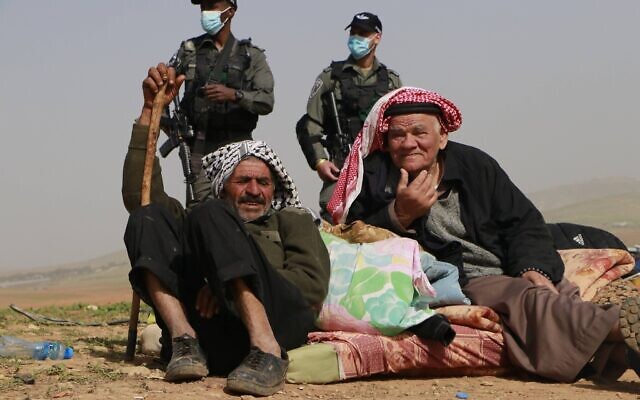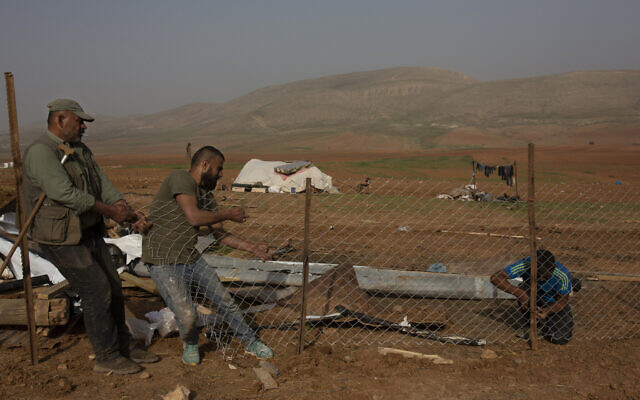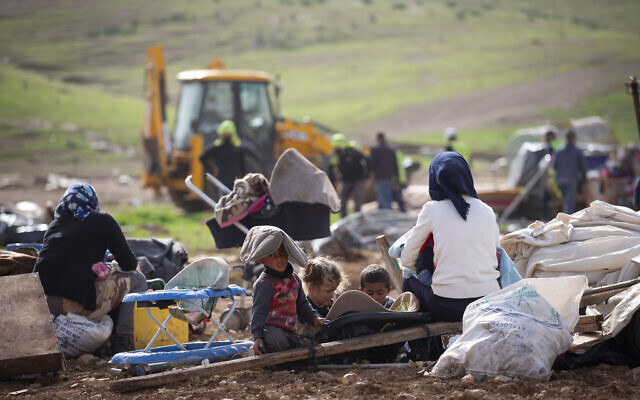Courts have ruled that Khirbet Humsa, thrice demolished by authorities in recent months, was built illegally in an Israeli military firing zone
By AARON BOXERMAN
7 July 2021,
YNET ISRAEL SOURCE

Palestinians and Israeli soldiers in Humsa al-Fouqa on Thursday, February 4, 2021 (Credit: WAFA/Suleiman Abu Srur)
Dozens of Palestinians saw their tents demolished again in the Jordan Valley on Wednesday morning as Israeli authorities took apart the small hamlet of Khirbet Humsa for at least the third time since November.
The hamlet is a collection of tents and pens for sheep, and most of the Palestinians living there are herders and belong to the same extended families.
Israel’s military liaison to the Palestinians said it destroyed structures that had been erected illegally on an Israeli military live-fire zone. Khirbet Humsa is one of 38 Bedouin communities on land the Israeli military has designated for training, according to the United Nations
“The [enforcement action] included the confiscation and demolition of tents that were once again illegally erected by Palestinian residents who invaded the firing range in the Jordan Valley in 2012,” the liaison, known by its acronym COGAT, said in a statement.
Palestinian residents see the demolitions as part of an attempt to remove their presence from the Jordan Valley. They also claim their presence predates 2012, going back decades.
At least 60 Palestinians live in the now-dismantled cluster of structures, according to residents.
“They give the settlers everything, but they won’t even allow us to stay here,” seethed Yasir Abu al-Kabbash, a local herder whose tent was confiscated.

Palestinian Bedouins rebuild a fence for an animal pen after Israeli troops demolished tents and other structures of the Khirbet Humsu hamlet in the Jordan Valley in the West Bank, Feb. 3, 2021. (AP Photo/Maya Alleruzzo)
The Jordan Valley is in Area C, under Israeli security and civilian control, according to the 1995 Oslo Accords. According to the agreements, Israel is responsible for planning and construction in the area.
Palestinians in Area C often clash with Israeli authorities over what Israel deems to be illegal construction. Israel asserts that Palestinians violate the law and engage in construction in illegal areas. Palestinians argue that Israel does not issue them enough permits or legalize existing villages, which they say amounts to an attempt to expunge their presence in the region.
Israel declared the area to be a live-fire zone in 1972, according to court filings. Humsa’s Bedouin residents appealed to the Israeli High Court to cancel their campsite’s impending demolition. In 2019, the court rejected the petition and ruled the herders had no right to stay in the area.
Israeli authorities have argued in court cases contesting firing zones that military training areas are designated with an eye to professional considerations, such as a locale’s unique topographic features.
Rights groups, however, allege that in some cases, areas have been declared firing zones as a means to cement Israeli control. Around 18 percent of the West Bank has been declared a live-fire zone, including some 30% of Area C, according to the UN.
According to a document discussed by the High Court last year, then-settlements minister Ariel Sharon explicitly told a 1981 committee meeting on West Bank settlement that the military would declare some areas to be training zones so as to check “the spread of Arab hill-villagers.”
“There are places which we have an interest in declaring to be live-fire zones, so as to ensure that they remain in our hands,” Sharon, who went on to become prime minister two decades later, told the committee.
Dror Etkes, who directs the left-wing Kerem Navot nonprofit, said that firing zones are occasionally redrawn to fit the needs of Jewish settlements. He pointed out that the town of Hemdat, which lies in a small pocket of legal land deep in the same firing zone as Humsa, has seen the training grounds redrawn so as to allow the town to spread further.
“You have [Jewish] settler outposts that are deep in firing zones and no one touches them. There are even cases, such as in Mitzpeh Kramim, where the army has stated it’s willing to change the dimensions of the firing zone to fit the settlement,” Etkes charged in a February phone call.

In this Feb. 3, 2021, file, photo, Palestinian Bedouin watch Israeli troops demolish tents and other structures of the Khirbet Humsu hamlet in the Jordan Valley in the West Bank (AP Photo/Majdi Mohammed)
A Defense Ministry official said on condition of anonymity that “official Israeli representatives” had offered the residents a nearby location in which to live, although they did not specify where.
“Despite repeated offers and attempts, the residents rejected all offers made to evacuate from the firing range and move to the alternative location offered to them,” the Defense Ministry official said.
Abu al-Kabbash claimed the land in question was quite far away, near the West Bank city of Nablus, on land that belonged to other Palestinian families.
“Would it be right for you to steal someone else’s car to give to me as a present?” Abu al-Kabbash said. “We’re not leaving this place.”
No comments:
Post a Comment